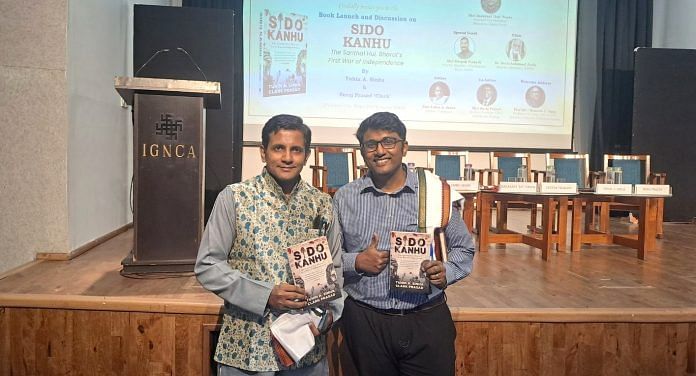Ever since the BJP came to power, India’s freedom struggle and historical battles have got a whole new array of revolutionaries to revere. A number of books, films and government commemorations have thrown up new historical figures to celebrate from the backyard of hidden histories. Books such as Guru Prakash’s Makers of Modern Dalit History, P. Sainath’s The Last Heroes, and Sanjeev Sanyal’s Revolutionaries have featured subaltern freedom fighters; in Assam, people have rediscovered the Ahom king Lachit Borphukan. The Ministry of Culture also released its third comic book on the stories of 20 tribal freedom fighters at the Tiranga Utsav celebration in New Delhi last year.
And now, it’s the novels that are catching up.
Tuhin A Sinha and Suraj Prasad’s latest work, Sido Kanhu: The Santhal Hul, Bharat’s First War of Independence, is another addition to the emerging trend of digging up subaltern voices that contributed to making ‘India’.
According to Sinha, Indian history has long been written “for a particular family”, to “glorify the particular family”. History writers, thus, have done injustice to tribal communities by pushing their contributions to the freedom struggle to the periphery. This book is their “humble attempt to correct that mistake,” announced Sinha at the launch of the book at the Indira Gandhi National Centre for the Arts recently.
As the title suggests, the novel narrates the story of Sido and Kanhu Murmu, the two tribal brothers whose exemplary courage mobilised thousands of Santhals against British colonialists. While growing up in Jharkhand’s Jamshedpur, Sinha was surrounded by tribal relics – such as Birsa Munda statues and chowks – that never failed to pick at his curiosity.
After writing almost 10 novels, he was convinced that “if he didn’t write about this subject now, he might never.” Taking the real-world information of Sido-Kanhu, the authors, with their creative inputs patched into the story, wrote a book that would make the narrative of these unsung heroes accessible to the general public. “The idea is to look into the past and take these stories forward,” co-author Prasad, whose literary name is Clark Prasad, told ThePrint.
Also read: Savarkar broke monopoly of Nehru-Gandhi history books. Now there’s new appetite, wishlist
1855 — first war of independence
In 1855, the Santhal Hul, led by Sido and Kanhu, became pivotal in the Santhal community’s fight against the East India Company’s oppression. Triggered by land loss, forced labour, and cultural suppression under British rule, the Hul rebellion was executed strategically. Sido and Kanhu used cultural symbols such as the Sal tree and stories of past struggles to unite people. They attacked colonial symbols smartly, targeting police stations and revenue offices. Guerrilla tactics disrupted British communication, aided by family and spiritual leader Bhaiji. Sido and Kanhu’s leadership fostered unity and resilience among the Santhals.
Though British military forces eventually suppressed the Hul, it made a lasting impact. The uprising brought attention to the plight of indigenous communities under colonial rule, leading to increased awareness of their rights and struggles. While immediate changes were limited, the Hul set the stage for broader shifts in policies, land reforms, and recognition of tribal leadership. Soon after, Santhal Pargana was formed as a separate district in 1855, and the Santhal Pargana Tenancy Act (SPTA) was passed in 1876, prohibiting the sale of Adivasi land to non-Adivasis. The law was later codified in 1949.
Also read: Mini JLFs sprouting across India. Lit fest boom in Nagpur, Ranchi, Kanpur, Indore, Kokrajhar
Past forward 150 years
Going back to the mid-19th century with India currently in its ‘Amrit Kaal’ might seem like reading a book backwards, said Sinha and the panellists. But the general consensus was that these unheard stories and unsung heroes needed to be brought into the limelight. Baijayant Jay Panda, BJP national vice president and chief guest at the book launch, which he termed as a congregation of “lekh premi, itihaas premi, aur desh premi,” shared insights on what local rebellions like the Hul signify. Their catalysts may have varied, but they all shared a common enemy – colonial domination. “The fundamental freedom they aimed for is the freedom of mind,” he said, addressing the audience.
The Murmu family, all under 30-35, fought for what impinged on their autonomy. Isn’t that exactly what freedom of mind is? Panda certainly agreed.
Songs commemorating the rebellion can still be heard around the Damin-i-Koh hills, and Sinha even played one for the audience:
“Sido, why are you bathed in blood?
Kanhu, why do you cry Hul Hul?”
These important, detailed subaltern narratives were glossed over, and, as Sinha said in his concluding remarks, “The God lies in the details.” The authors hope indigenous stories, such as those of Sido and Kanhu, will be included and taught in schools.
(Edited by Zoya Bhatti)



